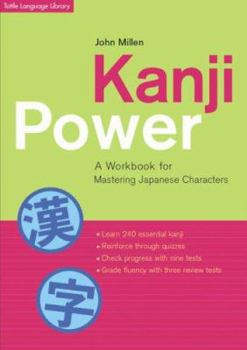Kanji Power: A Workbook for Mastering Japanese Characters a Workbook for Mastering Japanese Characters
This text presents advice on how to read, write and use 240 of the most commonly-used characters in Japanese. This description may be from another edition of this product.
Format:Paperback
Language:English
ISBN:0804817251
ISBN13:9780804817257
Release Date:January 1993
Publisher:Tuttle Publishing
Length:192 Pages
Weight:1.05 lbs.
Dimensions:0.5" x 7.0" x 10.2"
Customer Reviews
3 ratings
Useful
Published by Thriftbooks.com User , 16 years ago
I have found this to be a very useful book. I like the practice exercises. However,the tests are a little difficult, in large part because they contain kanji characters not yet learned (or even of a higher level than the book). This makes them a bit discouraging. Also the lack of an index can be rather frustrating.
Grades 1 and 2
Published by Thriftbooks.com User , 19 years ago
Kanji Power presents the level 1 and 2 joyo kanji, which Japanese kids learn in their first two years of school. Learning by frequency of occurence (such as with many of the kanji cards available) may be a better approach, depending on your goals. If you want to read children's books and the like, go with the joyo ordering -- you'll get furigana for higher-level kanji. The presentation is fairly rote, like how it's taught in the schools, which will prove more effective for some than others. I personally need mnemonics and am interested in how the kanjis came to be, but I have Kanji Pictographix and Read Japanese Today for this purpose.
My favorite kanji book
Published by Thriftbooks.com User , 20 years ago
I have a bunch of kanji books, but Kanji Power is my favorite. I'm not a big fan of the kind that give you mnemonics to help remember the kanji, because then the mnemonic is just another thing to remember. I do pretty well with just plain memorization.For each kanji entry, the following details are provided: on-yomi, kun-yomi, meaning, explanation of the character's shape, example sentences, common compounds, and writing practice (with tips on writing them correctly). I like that the readings are written in kana, because I'm always suspicious of romaji. Also, it helps me remember them better.There are also quizzes and tests, but I don't find them useful. While all the kanji compounds it tests you on are listed in the kanji entry, they're not words I find very useful or common. For example, the entry for "shi/ichi" (city, market) includes these "common" compounds: "shikyou" (market conditions), "shichou" (mayor), "shiyakusho" (city hall), and "kabushiki-shijou" (stock exchange).Personally, I like Hadamitzky and Spahn's way of showing compounds. Only compounds with kanji that have been learned previously are used. That way, even if the words aren't so common, you can write the whole word. However, I don't like the way they order the kanji, and learning them out of order makes that feature pointless.





